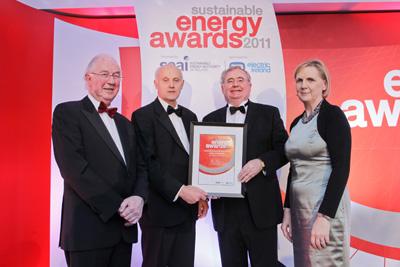Irish Aviation Authority photo of a plane flying over Air Traffic Control at Dublin Airport
The Irish Aviation Authority (IAA) has received a pivotal sustainability award for its work in optimising airline routes to cut distances travelled by 2.2m kilometres, saving 16m litres of airline fuel per annum. It’s also influencing other global aviation authorities to adapt cleaner technologies to reduce their CO2 footprints.
The IAA, which employs 700 people across Ireland, is a commercial semi-state body. Its cost-saving initiatives have included a freeze on safety regulation charges and the re-design of airspace.
The Sustainable Energy Awards were set up in Ireland to reward companies, irrespective of their sizes, for their energy management practises.
The Sustainable Energy Authority of Ireland (SEAI) hosted the awards, which were sponsored by ESB Electric Ireland this year.
Sustainability imperative for companies: cut costs/environmental responsibility
In Europe, embedding sustainability practices into their business planning has become top of the agenda of late for many businesses – large and small – to streamline costs, comply with EU regulations on CO2 outputs, and try to stay afloat in an unstable energy environment.
Energy security is also in the global spotlight, with nations starting to recognise the need to migrate to renewable forms of energy and integrate intermittent sources of energy, such as wind, into their networks, creating smarter grid infrastructures, and ultimately making electricity cheaper and cleaner, helping slow down the damage to our fragile planet and atmosphere for future generations.
The Sustainability Awards themselves in Ireland attracted attracted 105 entries from organisations of all sizes.
So why did the IAA’s greening strategy win the judges’ ultimate approval?
- 47,000 tonnes of carbon emissions have been saved as a direct result of the IAA’s investment in systems and technology and the continuous optimisation of Irish airspace structure and routes over the past 12 months.
- The IAA’s strategy is now being implemented by other air authorities, including the Maastricht Air Traffic Control Centre which controls traffic over Germany, Holland and the Benelux countries.

Brendan Halligan, chairman, SEAI; Sean McAdam O’Connell, IAA; Minister for Communications, Energy and Natural Resources, Pat Rabbitte, TD; and Brid Horan, executive director, ESB Electric Ireland
Ireland is paving the way for cleaner aviation
Eamonn Brennan, CEO, IAA, spoke this morning about how Ireland is leading the way in air traffic management (ATM) systems and technology.
He said this technology investment has resulted in increased safety, better efficiency of airline operations and reduction in the environmental impact of air travel, while at the same time supporting sustainable aviation and providing capacity out to 2020.
“Airline passengers would not be aware, but we have dramatically enhanced our systems and technologies and streamlined air traffic operations and routes through Irish airspace,” said Brennan.
Congratulating the 2011 award winners, Minister for Communications, Energy and Natural Resources Pat Rabbitte, TD, said the economic results we were seeing from the organisations entering the awards were very encouraging.
“These translate directly into more cost-competitive businesses and more cost-efficient public services. By implementing energy-efficient standards and practices we have a seen an average of 13pc energy savings across all organisations involved in this year’s Sustainable Energy Awards. I congratulate all who took these steps to become more energy efficient and I urge other companies to get involved,” Rabbitte said.
Retrofitting and smart buildings
Prof J Owen Lewis, SEAI chief executive, SEAI, spoke about how businesses around Ireland are really embracing sustainable energy and the results show that every change implemented has made a significant difference.
“Each year, we see more companies entering with exciting projects that are saving energy and benefiting their bottom line. Apart from showing leadership in energy management, a number of this year’s entrants have delivered significant retrofitting projects to buildings and facilities.
“We are also seeing smart new business solutions using leading-edge technologies, as well as new visions of sustainable energy communities emerging. These are very promising trends and we need to see this momentum continuing in the times immediately ahead. I congratulate all the winners and finalists,” he said.